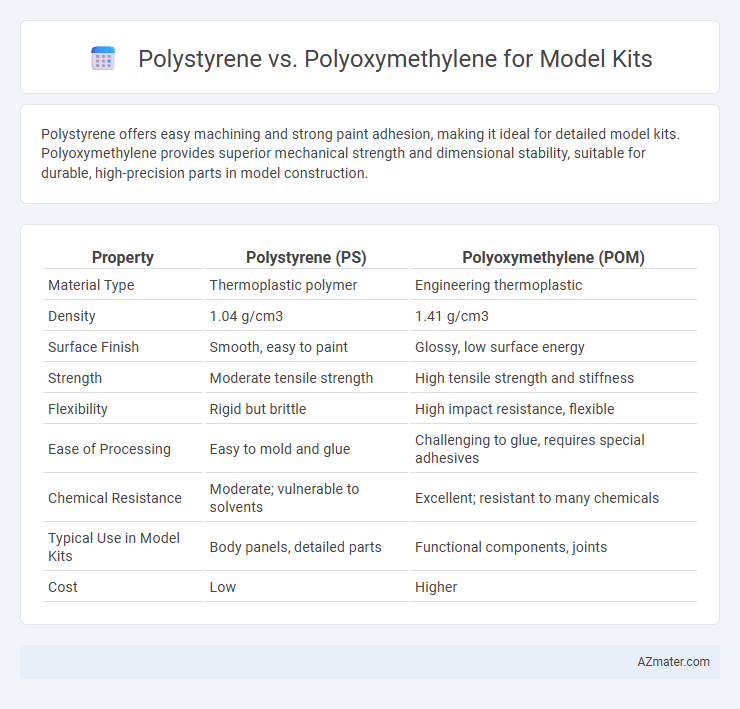Polystyrene offers easy machining and strong paint adhesion, making it ideal for detailed model kits. Polyoxymethylene provides superior mechanical strength and dimensional stability, suitable for durable, high-precision parts in model construction.
Table of Comparison
| Property | Polystyrene (PS) | Polyoxymethylene (POM) |
|---|---|---|
| Material Type | Thermoplastic polymer | Engineering thermoplastic |
| Density | 1.04 g/cm3 | 1.41 g/cm3 |
| Surface Finish | Smooth, easy to paint | Glossy, low surface energy |
| Strength | Moderate tensile strength | High tensile strength and stiffness |
| Flexibility | Rigid but brittle | High impact resistance, flexible |
| Ease of Processing | Easy to mold and glue | Challenging to glue, requires special adhesives |
| Chemical Resistance | Moderate; vulnerable to solvents | Excellent; resistant to many chemicals |
| Typical Use in Model Kits | Body panels, detailed parts | Functional components, joints |
| Cost | Low | Higher |
Introduction to Polystyrene and Polyoxymethylene in Model Kits
Polystyrene is the most commonly used plastic in model kits due to its ease of molding, cutting, and gluing, offering excellent surface detail and paint adhesion for scale models. Polyoxymethylene, known as acetal, provides superior mechanical strength, low friction, and dimensional stability, making it ideal for functional parts requiring durability and precision in model kits. Both materials serve distinct roles, with polystyrene favored for intricate exterior details and polyoxymethylene chosen for robust, moving components.
Material Properties Comparison: Polystyrene vs Polyoxymethylene
Polystyrene offers excellent ease of molding and surface detail, making it the standard choice for intricate model kits. Polyoxymethylene (POM) provides superior mechanical strength, higher stiffness, and enhanced wear resistance, ideal for functional parts requiring durability and low friction. While polystyrene excels in paint adhesion and affordability, polyoxymethylene delivers better dimensional stability and chemical resistance, crucial for long-lasting model components.
Ease of Cutting and Shaping
Polystyrene offers superior ease of cutting and shaping for model kits due to its softer texture and ability to be precisely trimmed with hobby knives and scalpels, making it ideal for intricate detailing. Polyoxymethylene (POM), while highly durable and wear-resistant, presents challenges in shaping because of its higher density and toughness, often requiring specialized cutting tools like rotary cutters or hot-wire cutters. Model builders prioritize polystyrene for ease of customization, while polyoxymethylene suits components needing structural stability where detailed shaping is minimal.
Surface Finish and Detailing Capabilities
Polystyrene offers a smooth surface finish ideal for painting and fine detailing in model kits, making it the preferred choice for intricate parts requiring crisp edges. Polyoxymethylene, while known for its high strength and durability, typically has a slightly rougher texture that can obscure fine details and may require additional surface preparation. Model builders often select polystyrene to achieve superior surface quality and precise detailing, especially in scale models with complex features.
Strength and Durability in Model Construction
Polystyrene offers moderate strength and ease of detailing, making it suitable for intricate model kits but may be prone to brittleness under stress. Polyoxymethylene (POM), also known as acetal, provides superior tensile strength and exceptional durability, ensuring better resistance to mechanical wear and deformation in demanding model construction. Choosing POM enhances model longevity and structural integrity, while polystyrene remains preferred for finely detailed, less load-bearing components.
Glue Compatibility and Joint Strength
Polystyrene is widely favored for model kits due to its excellent compatibility with solvent-based glues like polystyrene cement, which chemically bonds and creates strong, durable joints. Polyoxymethylene (POM), or acetal, presents challenges as it is resistant to most adhesives, requiring specialized epoxies or surface preparation for effective bonding. The joint strength achieved with polystyrene typically exceeds that of polyoxymethylene without additional treatment, making polystyrene the preferred material for models needing robust assembly.
Paint Adhesion and Surface Preparation
Polystyrene offers superior paint adhesion for model kits due to its smooth surface and compatibility with a wide range of primers and paints, ensuring vibrant and durable finishes. Polyoxymethylene (POM), being chemically inert and highly resistant to solvents, often requires specialized surface preparation such as sanding or priming with adhesion promoters to achieve satisfactory paint bonding. Proper surface preparation on both materials, including cleaning and light abrasion, significantly enhances primer acceptance and final paint durability on model kit components.
Weight and Balance in Finished Models
Polystyrene offers a lightweight structure for model kits, contributing to ease of handling and better balance during assembly, while polyoxymethylene provides enhanced rigidity but results in a heavier finished model that can affect stability. The density of polystyrene, around 1.05 g/cm3, ensures models remain manageable and balanced without sacrificing detail. In contrast, polyoxymethylene's higher density, approximately 1.41 g/cm3, increases weight, potentially shifting the model's center of gravity and requiring additional support for optimal balance.
Cost and Availability for Hobbyists
Polystyrene is widely preferred for model kits due to its low cost and high availability, making it accessible for hobbyists on a budget. Polyoxymethylene (POM), while offering superior mechanical strength and durability, is considerably more expensive and less commonly stocked by suppliers catering to model enthusiasts. The affordability and ease of purchase of polystyrene contribute significantly to its dominance in the model kit market.
Best Applications: When to Use Polystyrene or Polyoxymethylene
Polystyrene excels in model kit applications requiring easy molding, painting, and intricate detailing due to its excellent surface finish and compatibility with adhesives. Polyoxymethylene (POM) is best used for durable, high-wear components within model kits, such as mechanical parts or joints, thanks to its superior strength, stiffness, and low friction properties. Selecting Polystyrene suits visual and lightweight parts, while POM optimizes functional, load-bearing sections for enhanced longevity and performance.

Infographic: Polystyrene vs Polyoxymethylene for Model Kit
 azmater.com
azmater.com